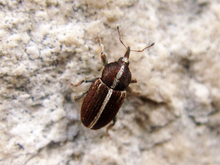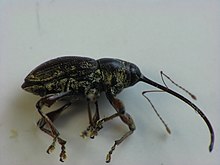The beetle subfamily Curculioninae is part of the weevil family Curculionidae. It contains over 23,500 described species in 2,200 genera, and is therefore the largest weevil subfamily. Given that the beetle order (Coleoptera) contains about one-quarter of all known organisms, the Curculioninae represent one of the – if not the – most successful radiations of terrestrial Metazoa.[1]
| Curculioninae | |
|---|---|

| |
| Dorytomus melanophthalmus, North Wales | |
| Scientific classification | |
| Domain: | Eukaryota |
| Kingdom: | Animalia |
| Phylum: | Arthropoda |
| Class: | Insecta |
| Order: | Coleoptera |
| Suborder: | Polyphaga |
| Infraorder: | Cucujiformia |
| Family: | Curculionidae |
| Subfamily: | Curculioninae Latreille, 1802 |
| Diversity | |
| About 30 tribes | |



Many weevils of this group are commonly known as flower weevils or acorn and nut weevils, after a food commonly eaten by Curculioninae larvae and imagines — the reproductive organs of plants.
Systematics
editThis large subfamily is divided into around 30 tribes. Delimitation of the Curculioninae is fairly robust considering its enormous size; there is some dispute, however, in their exact boundary with the Molytinae. The Phrynixini and Trypetidini are also included in the Curculioninae by some authors, but more often they are considered Molytinae; conversely, the Itini are usually placed in the Curculioninae but sometimes in the Molytinae, which are also expanded by certain authors to include, among others, the whole Cryptorhynchinae. These, as well as the Ceutorhynchinae, are sometimes included in the Curculioninae as additional tribes Cryptorhynchini and Ceutorhynchini. And some genera while almost certainly Curculioninae, are too unusual and/or ancient to be easily assigned to a specific tribe.
Features used to distinguish some of the tribes are:
| Pygidium exposed | Acalyptini[2] Ceutorhynchini |
| Foreleg femora with large triangular tooth | Camarotini[3] |
| Tarsi with one claw (not two) | Cryptoplini (including Haplonychini) |
| Mandibular (chewing) motion vertical (not horizontal) | some Curculionini |
| Prothorax with lateral keels | Derelomini[2] |
| Prothorax narrowed at base (ant mimic) | Erodiscini[3] Otidocephalini |
| Hindleg femora enlarged | Eugnomini (with triangular tooth) Rhamphini (swollen for jumping) |
| Tarsal claws fused at base | Smicronychini[3] |
| Prosternum anterior to foreleg coxae has a groove into which the rostrum is tucked (if groove continues posterior to coxae: Cryptorhynchinae) |
Storeini |
List of tribes
editThe subfamily Curculioninae consists of the following tribes:[4]
Some notable genera are also listed.
- Acalyptini Thomson, 1859
- AcentriniSeidlitz, 1890[5]
- Acentrusini Alonso-Zarazaga, 2005
- Ancylocnemidini Voss, 1962
- Anoplini Bedel, 1884[5][6]
- Anthonomini Thomson, 1859
- Camarotini Schönherr, 1833
- Ceratopodini Lacordaire, 1863
- Cionini Schönherr, 1825
- Cranopoeini Kuschel, 2009
- Cryptoplini Lacordaire, 1863
- Curculionini Latreille, 1802
- Derelomini Lacordaire, 1865
- Diabathrariini Lacordaire, 1863
- Ellescini Thomson, 1859
- Erodiscini Lacordaire, 1863
- Eugnomini Lacordaire, 1863
- Geochini Zimmerman, 1994[6]
- Gonipterini Lacordaire, 1863
- Itini Reitter, 1913[6]
- Mecinini Gistel, 1848
- Neosharpiini Hoffmann, 1956[6]
- Nerthopini Lacordaire, 1865
- Otidocephalini Lacordaire, 1863
- Piazorhinini Lacordaire, 1863
- Prionobrachiini Hustache, 1938
- Pyropini Lacordaire, 1865
- Rhamphini Rafinesque, 1815
- Smicronychini Seidlitz, 1891
- Sphaeriopoeini Kuschel, 2003
- Storeini Lacordaire, 1863
- Styphlini Jekel, 1861
- Tychiini Gistel, 1848
- Ulomascini Lacordaire, 1865
- Viticiini Morimoto, 1983
See also
editFootnotes
edit- ^ Kuschel 1995
- ^ a b Kojima & Morimoto 2005
- ^ a b c Marvaldi & Lanteri 2005
- ^ Bouchard P, Bousquet Y, Davies AE, Alonso-Zarazaga MA, Lawrence JF, Lyal CH, Newton AF, Reid CA, Schmitt M, Slipiński SA, Smith AB (April 2011). "Family-group names in Coleoptera (Insecta)". ZooKeys (88): 1–972. doi:10.3897/zookeys.88.807. PMC 3088472. PMID 21594053.
- ^ a b "Fauna Europaea, Curculioninae".
- ^ a b c d "weevil.info, Curculioninae".
References
edit- Kuschel, G. (1995). "A phylogenetic classification of Curculionoidea to families and subfamilies". In Anderson, R.S.; Lyal, C.H.C. (eds.). Biology and Phylogeny of Curculionoidea. Memoirs of the Entomological Society of Washington. Vol. 14. pp. 5–33.
- Marvaldi, A.E.; Lanteri, A.A. (2005). "Key to higher taxa of South American weevils based on adult characters (Coleoptera, Curculionoidea)" (PDF). Revista Chilena de Historia Natural. 78 (1): 65–87. doi:10.4067/s0716-078x2005000100006.
- Kojima, H.; Morimoto, K. (2005). "Weevils of the Tribe Acalyptini (Coleoptera: Curculionidae: Curculioninae): Redefinition and a taxonomic treatment of the Japanese, Korean and Taiwanese species" (PDF). Esakia. 45: 69–115. doi:10.5109/2704. S2CID 86802907. Archived from the original (PDF) on 2011-07-18. Retrieved 2009-04-06.
External links
edit- Media related to Curculioninae at Wikimedia Commons
- Data related to Curculioninae at Wikispecies